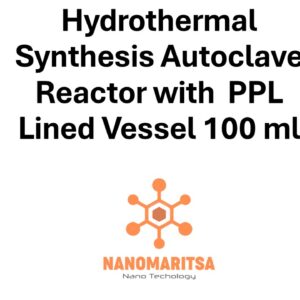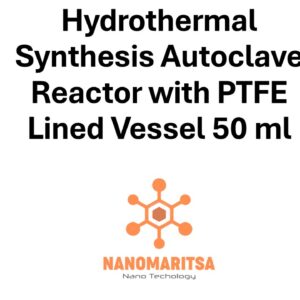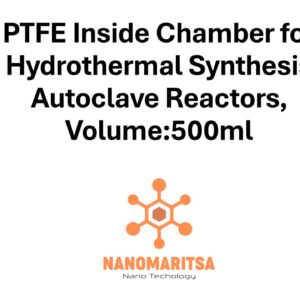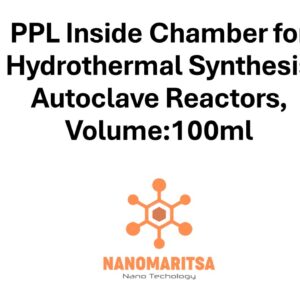PTFE Inside Chamber for Hydrothermal Synthesis Autoclave Reactors, Volume:50ml
€80.00
ComparePTFE Inside Chamber for Hydrothermal Synthesis Autoclave Reactors (50 ml) is a component specifically designed for use in hydrothermal synthesis autoclave reactors. This chamber is where the actual chemical reactions or material syntheses occur under high temperature and pressure conditions. Below is an overview of its key features, properties, applications, and handling considerations:
1. Key Features:
- PTFE Lining: The PTFE (polytetrafluoroethylene) inside chamber is a key feature of this component. PTFE is an extremely chemically inert material, which makes it ideal for use in hydrothermal synthesis reactions that often involve highly reactive or corrosive chemicals. The PTFE lining ensures that the chamber does not react with the substances inside, ensuring the purity and stability of the reaction.
- Volume (50 ml): The chamber has a volume of 50 milliliters (ml), making it suitable for small-scale hydrothermal reactions. This is ideal for research, prototyping, and laboratory-scale material synthesis, where only a small amount of material is needed.
- Pressure and Temperature Resistant: The PTFE chamber is designed to withstand high pressures and temperatures, typically in the range of 150°C to 250°C, and pressures up to 200-300 bar. This makes it suitable for a variety of hydrothermal synthesis processes.
- Sealed Environment: The chamber is designed to be sealed within the autoclave reactor, ensuring that the contents are kept under controlled conditions of temperature and pressure. This is essential for achieving the desired material properties and reaction outcomes.
2. Properties:
- Chemical Inertness: PTFE is chemically resistant to acids, bases, and most solvents, ensuring that it will not interact with the reactants inside the chamber. This property is crucial for maintaining the integrity of sensitive chemical reactions.
- High Temperature and Pressure Tolerance: PTFE can withstand high temperatures (up to 250°C) and high pressures (200-300 bar), making it ideal for hydrothermal synthesis, which requires such extreme conditions to drive chemical reactions.
- Non-Stick Surface: The PTFE lining provides a non-stick surface, which prevents materials from sticking to the walls of the chamber. This ensures that the reactants remain in solution or suspension and that the materials formed during the synthesis can be easily removed.
3. Applications:
- Nanomaterial Synthesis: The PTFE inside chamber is commonly used in the synthesis of nanoparticles and nanomaterials, which are needed in various industries such as electronics, energy storage, and catalysis.
- Crystal Growth: The chamber can be used to grow crystals under hydrothermal conditions, which is a widely used method for producing metal oxides, semiconductors, and other inorganic compounds.
- Catalysis and Chemical Reactions: The PTFE-lined chamber allows for the synthesis of catalysts or the execution of reactions that require high-temperature and high-pressure environments, which are necessary for the formation of certain materials.
- Energy Storage Materials: Hydrothermal synthesis is often employed to create materials for energy storage devices like supercapacitors, batteries, and fuel cells, and the PTFE chamber is used for these types of reactions.
- Environmental Applications: This chamber can be used for the synthesis of materials designed for environmental applications, such as catalysts for pollution control or materials for water purification.
4. Handling and Safety:
- Toxicity and Corrosiveness: While PTFE is highly resistant to most chemicals, some reagents may still pose toxicity risks. Always ensure that the chemicals used are compatible with PTFE and take necessary precautions when handling hazardous substances.
- High Pressure and Temperature Safety: The PTFE chamber is designed to operate under high-pressure and high-temperature conditions. It is essential to follow safety guidelines and manufacturer instructions to prevent accidents. Regularly check the seals and integrity of the PTFE lining to ensure it can safely contain the reaction conditions.
- Storage: After use, clean the PTFE chamber thoroughly to remove any chemical residues. Store it in a cool, dry place, away from direct sunlight or extreme temperatures.
- Precautions: Always wear appropriate personal protective equipment (PPE), such as gloves, goggles, and lab coats, when handling the PTFE chamber. Work in a well-ventilated area or a fume hood, particularly when dealing with volatile or toxic chemicals.
Summary:
The PTFE Inside Chamber for Hydrothermal Synthesis Autoclave Reactors (50 ml) is an essential component for performing high-temperature and high-pressure reactions in laboratory-scale hydrothermal synthesis. Its PTFE lining ensures chemical resistance, non-stick properties, and compatibility with a wide range of chemicals, making it ideal for the synthesis of nanoparticles, crystals, and other advanced materials. The 50 ml volume is suited for small-scale experiments, making it a valuable tool in material science, nanotechnology, and chemical research.
| Pieces | 1 Piece, 5 Pieces |
|---|






